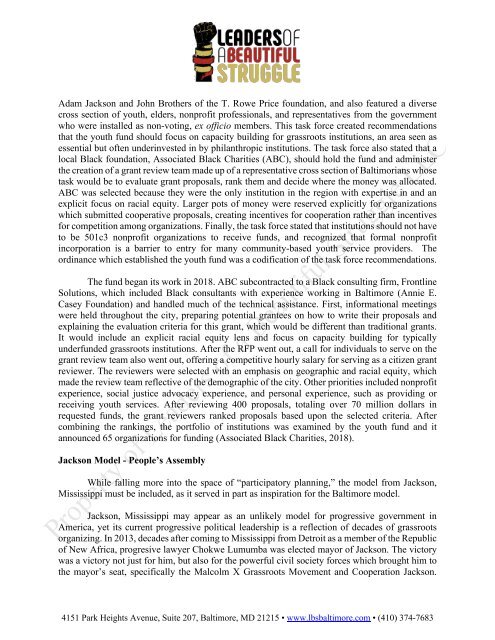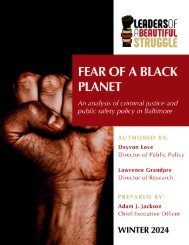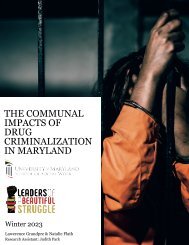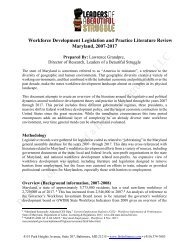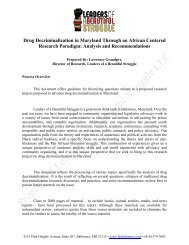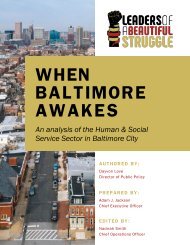Models for Participatory Budgeting
Participatory Budgeting (PB) has become a schizophrenic term, used as easily by neoliberal technocrats as it has been used by leftists seeking redistribution of wealth. As such, examining the function of any PB scheme with a critical lens is essential to determine whether it is an attempt to redistribute resources and power, or a tool to manufacture consent for the status quo and undermine/co-opt forces of resistance. While the goal of this analysis is not to delve deeply into the technical minutiae around the different processes, there is one clarification which may be useful to make at the beginning of the section. Much of what is often called PB could also be considered “participatory urban planning.” The distinction is that while budgeting denotes an explicit focus on allocating a discrete set of funds, planning seeks to take a more comprehensive survey of people's feelings, needs and problems, and generates a list of interventions based upon that feedback. Many straddle the line and include elements of both. This section will focus on processes which allocate revenue directly, will help explain why some interventions (Baltimore City Children and Youth Fund) will receive more direct attention and others (New York Cities Participatory Planning sessions) might receive less.
Participatory Budgeting (PB) has become a schizophrenic term, used as easily by neoliberal technocrats as it has been used by leftists seeking redistribution of wealth. As such, examining the function of any PB scheme with a critical lens is essential to determine whether it is an attempt to redistribute resources and power, or a tool to manufacture consent for the status quo and undermine/co-opt forces of resistance.
While the goal of this analysis is not to delve deeply into the technical minutiae around the different processes, there is one clarification which may be useful to make at the beginning of the section. Much of what is often called PB could also be considered “participatory urban planning.” The distinction is that while budgeting denotes an explicit focus on allocating a discrete set of funds, planning seeks to take a more comprehensive survey of people's feelings, needs and problems, and generates a list of interventions based upon that feedback. Many straddle the line and include elements of both. This section will focus on processes which allocate revenue directly, will help explain why some interventions (Baltimore City Children and Youth Fund) will receive more direct attention and others (New York Cities Participatory Planning sessions) might receive less.
- No tags were found...
Create successful ePaper yourself
Turn your PDF publications into a flip-book with our unique Google optimized e-Paper software.
Adam Jackson and John Brothers of the T. Rowe Price foundation, and also featured a diverse<br />
cross section of youth, elders, nonprofit professionals, and representatives from the government<br />
who were installed as non-voting, ex officio members. This task <strong>for</strong>ce created recommendations<br />
that the youth fund should focus on capacity building <strong>for</strong> grassroots institutions, an area seen as<br />
essential but often underinvested in by philanthropic institutions. The task <strong>for</strong>ce also stated that a<br />
local Black foundation, Associated Black Charities (ABC), should hold the fund and administer<br />
the creation of a grant review team made up of a representative cross section of Baltimorians whose<br />
task would be to evaluate grant proposals, rank them and decide where the money was allocated.<br />
ABC was selected because they were the only institution in the region with expertise in and an<br />
explicit focus on racial equity. Larger pots of money were reserved explicitly <strong>for</strong> organizations<br />
which submitted cooperative proposals, creating incentives <strong>for</strong> cooperation rather than incentives<br />
<strong>for</strong> competition among organizations. Finally, the task <strong>for</strong>ce stated that institutions should not have<br />
to be 501c3 nonprofit organizations to receive funds, and recognized that <strong>for</strong>mal nonprofit<br />
incorporation is a barrier to entry <strong>for</strong> many community-based youth service providers. The<br />
ordinance which established the youth fund was a codification of the task <strong>for</strong>ce recommendations.<br />
The fund began its work in 2018. ABC subcontracted to a Black consulting firm, Frontline<br />
Solutions, which included Black consultants with experience working in Baltimore (Annie E.<br />
Casey Foundation) and handled much of the technical assistance. First, in<strong>for</strong>mational meetings<br />
were held throughout the city, preparing potential grantees on how to write their proposals and<br />
explaining the evaluation criteria <strong>for</strong> this grant, which would be different than traditional grants.<br />
It would include an explicit racial equity lens and focus on capacity building <strong>for</strong> typically<br />
underfunded grassroots institutions. After the RFP went out, a call <strong>for</strong> individuals to serve on the<br />
grant review team also went out, offering a competitive hourly salary <strong>for</strong> serving as a citizen grant<br />
reviewer. The reviewers were selected with an emphasis on geographic and racial equity, which<br />
made the review team reflective of the demographic of the city. Other priorities included nonprofit<br />
experience, social justice advocacy experience, and personal experience, such as providing or<br />
receiving youth services. After reviewing 400 proposals, totaling over 70 million dollars in<br />
requested funds, the grant reviewers ranked proposals based upon the selected criteria. After<br />
combining the rankings, the portfolio of institutions was examined by the youth fund and it<br />
announced 65 organizations <strong>for</strong> funding (Associated Black Charities, 2018).<br />
Jackson Model - People’s Assembly<br />
While falling more into the space of “participatory planning,” the model from Jackson,<br />
Mississippi must be included, as it served in part as inspiration <strong>for</strong> the Baltimore model.<br />
Jackson, Mississippi may appear as an unlikely model <strong>for</strong> progressive government in<br />
America, yet its current progressive political leadership is a reflection of decades of grassroots<br />
organizing. In 2013, decades after coming to Mississippi from Detroit as a member of the Republic<br />
of New Africa, progresive lawyer Chokwe Lumumba was elected mayor of Jackson. The victory<br />
was a victory not just <strong>for</strong> him, but also <strong>for</strong> the powerful civil society <strong>for</strong>ces which brought him to<br />
the mayor’s seat, specifically the Malcolm X Grassroots Movement and Cooperation Jackson.<br />
4151 Park Heights Avenue, Suite 207, Baltimore, MD 21215 • www.lbsbaltimore.com • (410) 374-7683


